|
abot85-7
|
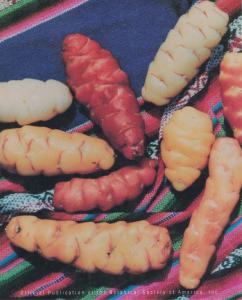
|
A sample of the diversity of tubers oca, Oxalis tuberosa Molina, from the germplasm bank of PROINPA (Programa de la Investigacion de la Papa), Cochabamba, Bolivia.
|
copyright: BSA,
license: http://images.botany.org/index.html#license |
Image
|
Systematics

|

|
|
abot85-8
|
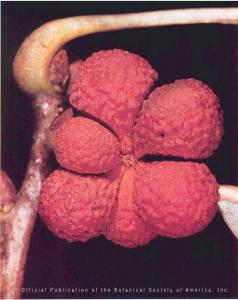
|
The
Oak galls of the wasp Adleria weldi occur on one year-old acorns.
Young, green galls secrete honeydew, but at maturity galls turn brown and
drop from their host. Shown here on Quercus myrtifolia, this wasp
also attacks Q. laurifolia in the southeastern United States. This species is incorrectly placed in Adleria and should be moved to the genus Andricus.
|
copyright: BSA,
license: http://images.botany.org/index.html#license |
Image
|
Systematics

|

|
|
abot85-9
|
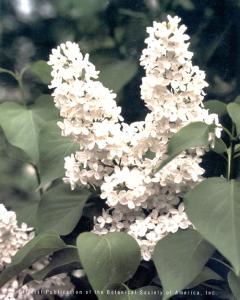
|
White-flowered form of Syringa vulgaris from the Arnold Arboretum of harvard University. Several hundred cultivars of lilacs were developed from 22 wild species through extensive hybridizatino and artificial selection. The parentage of several of these hybrids was confirmed using restriction site analysis of both chloroplast and nuclear ribosomal DNA.
|
copyright: BSA,
license: http://images.botany.org/index.html#license |
Image
|
Systematics and Phytogeography

|

|
|
abot86-1
|
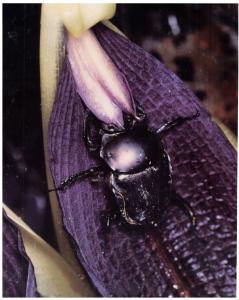
|
The dung beetle Paragymnopleurus pauliani (Scarabaeidae) is visiting the zygomorphic flower of Orchidantha inouei (Lowiaceae), presumably being attracted to the dung-like odor of the flower.
|
copyright: BSA,
license: http://images.botany.org/index.html#license |
Image
|
Reproductive Biology

|

|
|
abot86-10
|
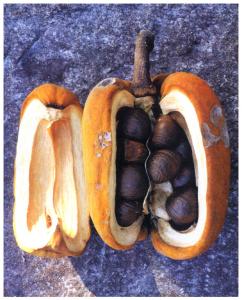
|
Fruiting capsule of a Pachira species from Estado Amazonas, Venezuela, which has been opened to show its large, floatable seeds. The seeds of other species in this genus of tropical trees are smaller and surrounded by dense, non-wettable hairs. Pachira is a member of the traditional family Bombacaceae, which like the Sterculiaceae and Tiliaceae has been found to be non-monophyletic.
|
copyright: BSA,
license: http://images.botany.org/index.html#license |
Image
|
Systematics

|

|
|
abot86-11
|
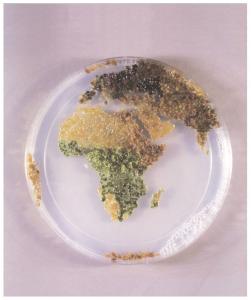
|
World in a petri dish constructed from various morphological mutants of the moss Funaria hygrometrica tries to capture the potential of mosses as a global experimental system for plant biology.
|
copyright: BSA,
license: http://images.botany.org/index.html#license |
Image
|
Physiology and Development

|

|
|
abot86-12
|
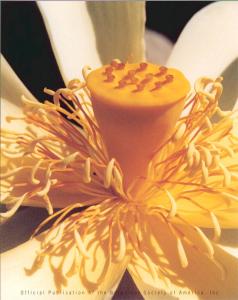
|
American lotus flower (Nelumbo lutea: Nelumbonaceae) on the second day of anthesis, showing a central, gynoecial receptacle and several whorls of dehiscent stamens. Historically, Nelumbo has been considered to be closely related to Nymphaeales (water lilies); however, new systematic work has allied the genus with lower eudicots.
|
copyright: BSA,
license: http://images.botany.org/index.html#license |
Image
|
Structure and Development

|

|
|
abot86-2
|
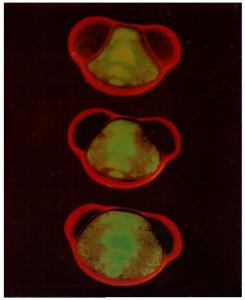
|
Time series during hydration of an oriental spruce (Picea orientalis) pollen grain. Rhodamine B stains the exine (red) while fluorescein diacetate crosses plasmalemmae and indicates esterase activity in the living cells (green). Swelling of the tube cell reduces the volume of the saccate air space and results in a loss of pollen buoyancy. Confocal extended depth of focus sections taken at (top to bottom) 1, 8, and 15 min after start of hydration.
|
copyright: BSA,
license: http://images.botany.org/index.html#license |
Image
|
Anatomy and Morphology

|

|
|
abot86-3
|
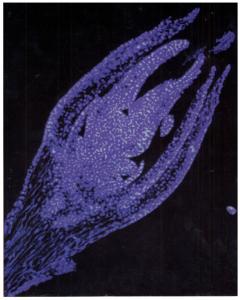
|
Longitudinal section of a pistillate floret of Heteropogon contortus, stained with DAPI. Nuclei are brightly stained in both gynoecium and anthers, even though the anthers have largely ceased growth.
|
copyright: BSA,
license: http://images.botany.org/index.html#license |
Image
|
Structure and Development

|

|
|
abot86-4
|
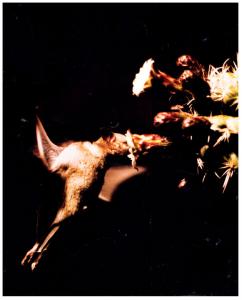
|
Leptonycteris curasoae visiting flowers of Stenocereus stellatus in a wild population in Zapotitlán de las Salinas, Tehuacán Valley, Mexico.
|
copyright: BSA,
license: http://images.botany.org/index.html#license |
Image
|
Population Biology

|

|
|
abot86-5
|
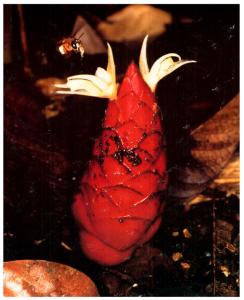
|
In the dark forest understory, white flowers of the ginger Zingiber longipedunculatum are pollinated by pollen-collecting female Amegilla bees (Anthophoridae). Ginger species in a Bornean forest show high diversity, but they were grouped into only three pollination guilds.
|
copyright: BSA,
license: http://images.botany.org/index.html#license |
Image
|
Reproductive Biology

|

|
|
abot86-6
|

|
View of "Tres Picos" (Three Peaks) from Villagra on Robinson Crusoe Island, which is in the Juan Fernandez archipelago off the coast of Chile. The closer vegetation represents the habitat for Lactoris fernandeziana (Lactoridaceae).
|
copyright: BSA,
license: http://images.botany.org/index.html#license |
Image
|
Reproductive Biology

|

|
|
abot86-7
|
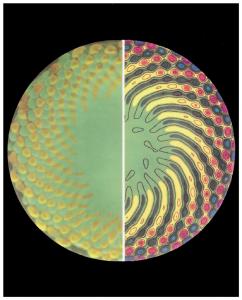
|
Scanning electron micrograph of a young sunflower capitulum (left) and simulation of the same structure based on mechanical buckling of a thin circular plate (right). One family of spirals is highlighted in yellow.
|
copyright: BSA,
license: http://images.botany.org/index.html#license |
Image
|
Development and Morphogenesis

|

|
|
abot86-8
|
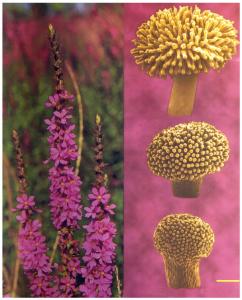
|
Inflorescence with flowers of purple loosestrife, Lythrum salicaria (left panel). Depending on the relative length of styles with respect to stamens within flowers, individuals are categorized into three floral morphs. The three floral morphs also differ in size and shape of stigmas (right panel). Stigmas (top–long morph, middle–mid morph, and bottom–short morph, in the right panel; bar = 200 µm) are digitally false-colored computer-enhanced images from scanning electron micrographs. Photo credit: M. Biernacki, T. K. Mal, R. J. Williams, and The Camera Shop, Broomall, Pennsylvania.
|
copyright: BSA,
license: http://images.botany.org/index.html#license |
Image
|
Reproductive Biology

|

|
|
abot86-9
|
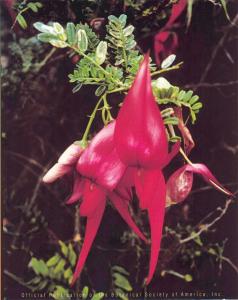
|
The kàkà beak, Clianthus puniceus (Fabaceae), is an endangered shrub that is endemic to New Zealand.
|
copyright: BSA,
license: http://images.botany.org/index.html#license |
Image
|
Systematics and Phytogeography

|

|
|
abot87-1
|
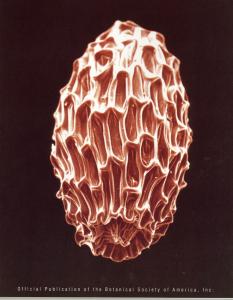
|
Color-enhanced scanning electron photomicrograph of a seed of Lobelia inflata (Campanulaceae). The seed's actual width is ~0.30 mm. An individual of this monocarpic and self-fertilizing species typically produces 50–100 fruits, each containing up to 500 seeds. This species has a strict light requirement for germination.
|
copyright: BSA,
license: http://images.botany.org/index.html#license |
Image
|
Reproductive Biology

|

|
|
abot87-10
|
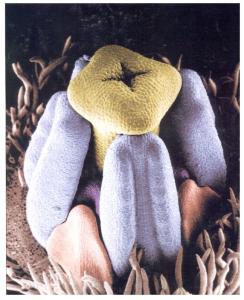
|
Scanning electron micrograph of an early floral developmental stage of the outcrossing subspecies of Clarkia xantania (Onagraceae). Sepals, which are covered by trichomes, have been partially removed and floral organs have been falsely colored: style and stigma, yellow; large anthers, blue; small anthers, purple; petals, red.
|
copyright: BSA,
license: http://images.botany.org/index.html#license |
Image
|
Structure and Development

|

|
|
abot87-11
|
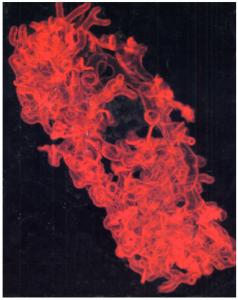
|
A projection of 29 confocal optical sections taken at 0.2-µm intervals through the hyphal network in an inner cortical cell of a root of Medicago truncatula colonized by arbuscular-mycorrhizal fungi. The root section was stained with Texas-Red conjugated to wheat germ agglutinin, which binds to the surface of the hyphae. Confocal images by E. B. Blancaflor, L. Zhao, and M. J. Harrison.
|
copyright: BSA,
license: http://images.botany.org/index.html#license |
Image
|
Plant cell biology

|

|
|
abot87-12
|
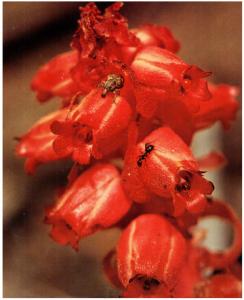
|
The nonphotosynthetic plant Sarcodes sanguinea (Monotropoideae, Ericaceae) receives all its carbon from the ectomycorrhizal basidiomycete Rhizopogon ellenae(Boletales) that proliferates in its immediate surroundings.
|
copyright: BSA,
license: http://images.botany.org/index.html#license |
Image
|
Ecology

|

|
|
abot87-2
|
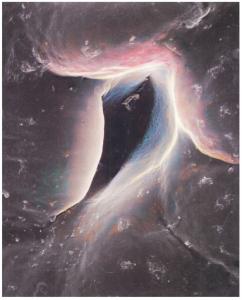
|
A stoma from the scale of a female cone of Rocky Mountain Douglas-fir (Pseudotsuga menziesii var. glauca). Magnification = 6800x. Photosynthesis and respiration of male and female cones of Douglas-fir may have significant effects on whole-tree physiology.
|
copyright: BSA,
license: http://images.botany.org/index.html#license |
Image
|
Ecology

|

|